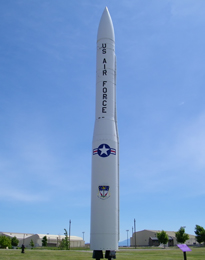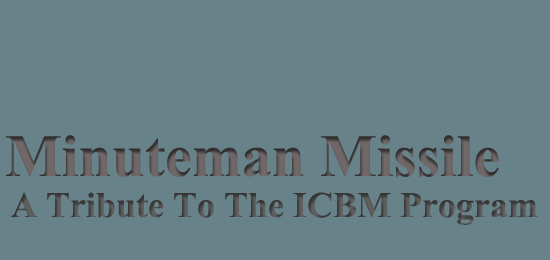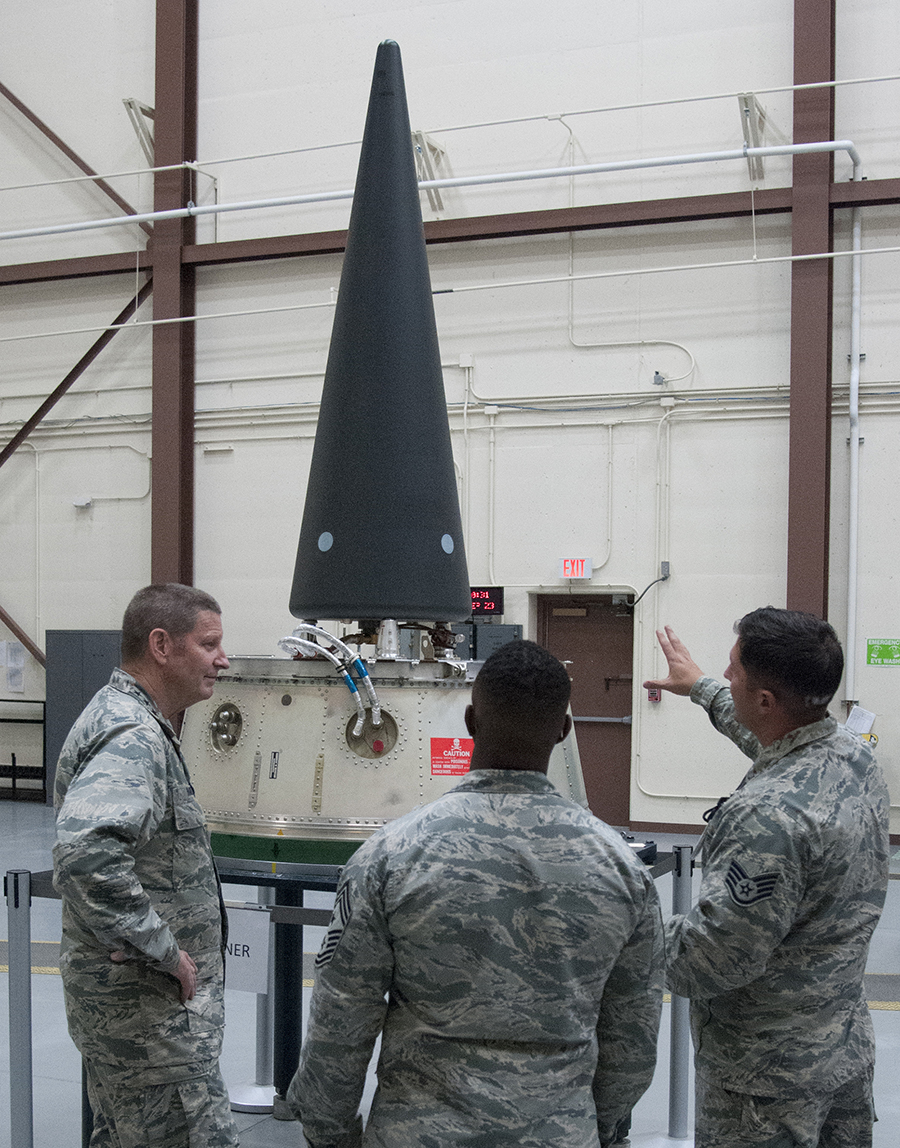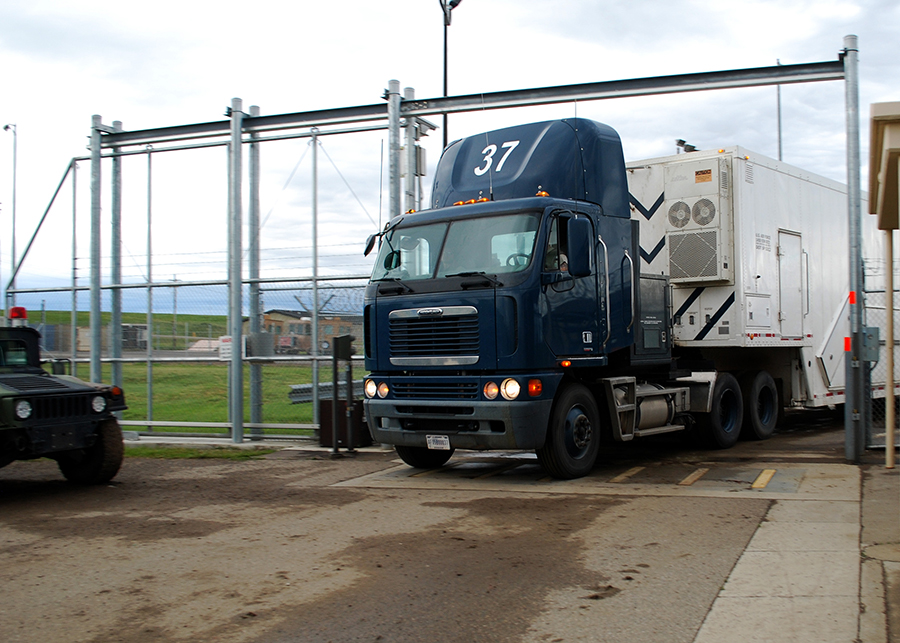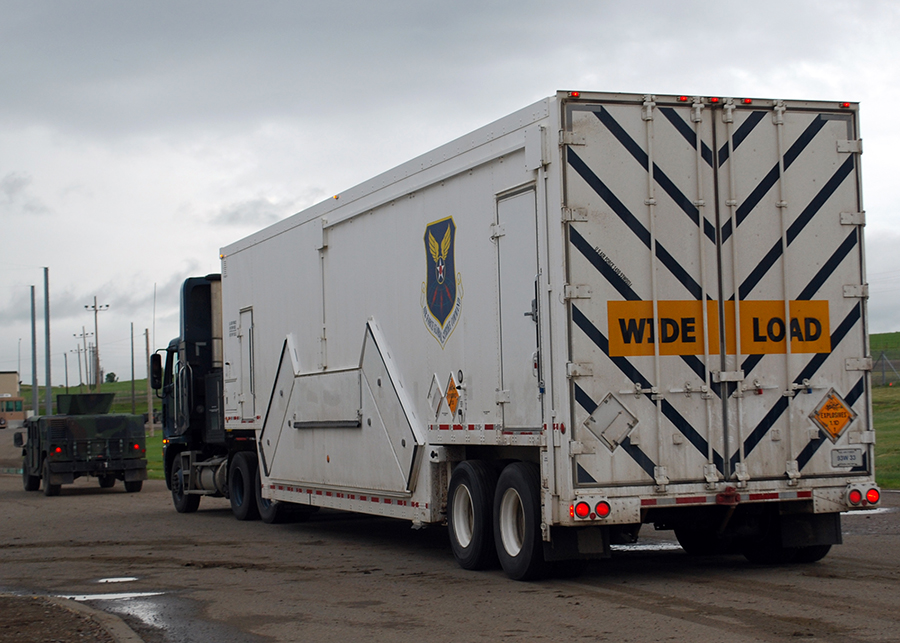MIRV - SRV
"DeMIRVing" Minuteman III Missiles
Beginning in 2001 the Air Force started implementing action in reducing the number of nuclear warheads that had been agreed upon, which all began dating back to the START I treaty. The START I treaty was signed by George H. W. Bush and Mikhail Gorbachev July 31, 1991. This treaty limited each nation to a total of 6000 nuclear warheads, per nation.
On January 3, 1993 President George H. W. Bush and Boris Yelstin signed the START II treaty that established a limit of approximately 3500 nuclear warheads. One of the premises of this agreement was banning the use of multiple independently targetable reentry vehicles (MIRV) on Intercontinental Ballistic Missiles. This treaty was often referred to as the De-MIRV-ing Agreement. Given the treaty was signed, the terms were never honored, based on a number of political events, namely the United States involvement in Kosovo. Many years went by with neither of the two nations coming to an agreement on ratification of the treaty.
Essentially the United States and Russia both lost interest in the START II treaty, which led to George W Bush stepping forward in 2001 with his suggestion that both nations reduce the total number of their warheads to 1,700 from 2,200. In November 2001 the beginning stages of establishing the SORT treaty was agreed to by Presidents George W. Bush and Vladimir Putin. Both presidents signed the SORT treaty at the Moscow Summit on May 24, 2002.
The SORT treaty, Strategic Offensive Reductions Treaty, states that the United States and Russia agreed to reduce operationally deployed strategic nuclear warheads to 1,700 from 2,200 by 2012. The month following the Moscow Summit, June 2002, found the United states withdrawing from the Anti Ballistic Missile (ABM) Treaty, and on the following day Russia announced that it would no longer consider itself to be bound by the START II provisions. Both countries continued to uphold their objectives: as of 2002 Russia was opting to retain 54 MIRV-capable RS-20/R-36 ICBM missiles (SS-18 Satan) with 10 warheads each, 40 MIRV-capable RS-18/UR-100N missiles (SS-19 Stiletto) with 6 warheads each and 24 MIRV-capable RS-24 Yars missiles with 3 warheads each, for an overall total of 852 deployed nuclear warheads.
Based on the United States no longer being bound by the ABM treaty, the US began developing the Ground-Based Midcourse Defense (GMD) system to protect from a small-scale ICBM attack.
In 2001, the United States started reducing its total number of warheads on its Minuteman III missile by "deMIRVing" the 150 Minuteman missiles at F.E. Warren AFB in Wyoming. What this entailed was removing 2 of the 3 warheads (each Minuteman III missile can carry a total of 3 warheads per missile) from all 150 Minuteman III missiles deployed at F.E. Warren Air Force Base. This was followed by the deactivation of the 50 Peacekeeper missiles at F.E. Warren starting in October 2002 and by September 19, 2005 all 50 Peacekeeper missiles were removed.
Over the years, the number of nuclear weapons has been steadily decreasing. The image above captures the Payload Transporter assigned to Malmstrom AFB in Great Falls, Montana. This transporter is returning to their Weapon Storage Area at Malmstrom, the last MIRV system pulled off the final MIRVed Minuteman missile deployed at Malmstrom AFB, making all 450 ICBM missiles in the United States a missile with a Single Reentry Vehicle, SRV.
In 2007, due to primarily maintenance costs, the Air Force started the deactivation process of the 564th Missile Squadron attached to the 341st Missile Wing at Malmstrom AFB. By 2008 all 50 of the Minuteman III missiles had been removed. This contributed to having an additional 150 Reentry Vehicles removed from deployed ICBMs.
Following the De-MIRVing of the 150 Minuteman III missiles at F.E. Warren AFB in 2001, both Malmstrom AFB and Minot AFB had the option of having 1 to 3 Reentry Vehicles on each of their Minuteman missiles. Some had 2, some had 3. Based on the agreement in the treaty, this allowed each Missile Wing the discretion of what they felt was necessary within their strategic nuclear mission. (For further information as to how this was addressed within the Air Force, refer to the Documents Library for articles in PDF form on this topic)
June 16, 2014 witnessed the end of multiple reentry vehicles on the Minuteman III missile in the United States
New START Treaty
The most current Treaty between the United States and the Russian Federation, on Measures for the Further Reduction and Limitation of Strategic Offensive Arms, also known as the New START Treaty, entered into force on February 5, 2011. Based on the configuration of this treaty, the United States and Russia must meet the Treaty's central limits on strategic arms by February 5, 2018; seven years from the date the Treaty entered into force.
Each Party has the flexibility to determine for itself the structure of its strategic forces within the aggregate limits of the Treaty. These limits are based on the thorough analysis conducted by Department of Defense planners in support of the 2010 Nuclear Posture Review.
Aggregate limits:
700 deployed Intercontinental Ballistic Missiles, deployed submarine ballistic missiles (SLBMs), and deployed heavy bombers equipped for nuclear armaments;
1550 nuclear warheads on deployed ICBMs, deployed SLBMs, and deployed heavy bombers equipped for nuclear armaments (each heavy bomber is counted as one warhead toward this limit);
800 deployed and non-deployed ICBM launchers, SLBM launchers and heavy bombers equipped for nuclear armaments.
Verification and Transparency
Verification parameters under the New START Treaty include on-site inspection and exhibitions, data exchanges and notifications related to strategic offensive arms, and facilities covered by the Treaty, and provisions to facilitate the use of national technical means for treaty monitoring. In the hopes of increasing confidence and transparency, the New START Treaty has outlined the provision of an annual exchange of telemetry on an agreed number of ICBM and SLBM launches.
New START Treaty Duration
The Treaty's duration is 10 years. The US and Russia may agree to extend the Treaty for a period of no more than 5 years. The Treaty also includes a withdrawal clause, which is standard in arms control agreements.
No Constraints on Missile Defense and Conventional Strike
The New START Treaty does not constrain testing, development, or deployment of current or planned U.S. missile defense programs or long-range strike capabilities.
